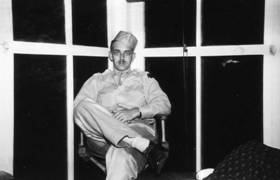
Colonel Donovan Milligan Vance
By Rob Ruglio
Chief of the military government in Japan, mayor of Monmouth, Illinois, and Director of the Illinois Civil Defense Agency may seem like enough responsibility for three men, but Donovan Vance did them all. To understand how he did them, one must look at the man behind the titles, to see how he became the person and leader he was.
Donovan Milligan Vance was born September 26, 1904, to Harry and Myrtle Vance in Warren County.[1] He received his middle name from his mother’s maiden name, a tradition the Colonel and his wife would continue with their son. His father was from Kansas,[2] and, before Donovan was born, deserted his family.[3] While he was a child, in 1908, his mother died from tuberculosis. During the summer, Donovan Vance was sent to New Mexico and Arizona and returned on the train, alone, to Monmouth until the death of his mother, when came back to live with his grandmother and his aunts.[4]
While he was growing up he could be found sitting outside on the porch of the McCullough residence with a Monmouth College student from Japan named Takashi Komatsu who boarded there, and cousin Ray Vance.[5] The McCulloughs had made their money through the ownership of the McCullough Lumber and Coal Company.[6] This friendship and connection with Komatsu would prove to be priceless in Donovan’s upcoming military career.
In 1921, at the age of 16, Donovan Vance lied to join the National Guard with longtime best friend, Mike “Milo” Gray, later to also become a colonel. In order to train with the National Guard, Donovan Vance had to come up with another lie to tell his grandmother, who would not have let him join the Guard. So for the two months of training that he and Gray had to finish, Donovan Vance told grandma Milligan that he was going to a farm to help harvest.[7]
In the National Guard, his leadership was rewarded by promotion to second lieutenant in 1922 and first lieutenant in 1923.[8] While preparing for his military career, Donovan Vance worked as a car salesman for a local dealership, selling Dodges and Plymouths for E & A (Engall and Anderson) Motor Sales.[9] During this time Donovan Vance, along with other members of the National Guard, took part in military training in the National Guard Armory. After work, many of the men went to the armory for a few hours. At five o’clock, or shortly after, the men would adjourn into the Officers Club, where they were able to relax and hang out with each other.[10] He attended Monmouth College, graduating with the class of 1928.
Donovan Vance married Miss Mildred “Milly” Louise Duke on January 30, 1926. The small ceremony was described in the paper later that day:
“Two of Monmouth’s well known young people, Miss Mildred Duke and Donovan M. Vance were quietly united in marriage at noon today at the home of the bride, 513 West Broadway. The wedding was solemnized in the present of only the immediate families of the two young people and Rev. R. H. Seitner of the First Baptist church read the double ring service. There were no attendants. The home was decorated with cut flowers and after the ceremony a three course breakfast was served.
The bride was beautifully attired in bois de rose crepe gown and carried a bride’s bouquet. She is a daughter of B. C. Duke of this city and is a prominent member of the younger social circle of the city. She attended Monmouth high school and later the Frances Shimer school at Mt. Carroll, Ill. Last year she attended school at Ferry Hall in Evanston.
The groom is a grandson of Mrs. M. E. Milligan of 218 West First avenue with whom he has made his home. He is a graduate of Monmouth high school and later attended Monmouth college and is a member of the Phi Kappa Pi fraternity. He is a member of Battery B of the National Guard Units and hold the rank of First Lieutenant. He had attended National Guard schools of instruction at Chicago and Ft. Fills, Okla.
Mr. and Mrs. Vance leave this afternoon for Chicago for a short wedding trip and after their return will be at home after February 15 on a farm at Rozetta. The young couple have the best wishes and congratulations of their large circle of friends.”[11]
Two years later the couple gave birth to their only child, Donovan Duke Vance (Don D).[12] The Duke family was one of the more prominent families in the area, owning a large amount of farmland, and also provided a connection between two men important later in Don D.’s life.[13] While his father attended military training, Don D. lived with his grandparents, the Dukes. Grandpa Duke was a big man, just as Don D. was a big boy himself, and always made sure the boys, Don D. and his friends, ate a lot during meals while Donovan Vance was away, saying the phrase, “Have another helping, because I know how boys like to eat.”[14] Don D., like his father Donovan Vance, spent a lot of his childhood in the house of his grandparents. Even while being in the National Guard, Donovan Vance still showed interest in his son’s activities, as described by Mr. Bill Smallwood:
“Back when we were in high school, one thing I remember, Don (Duke) and I were both on the track team, and this was still during the war situation when gas was rationed. They didn’t take us by bus, we had to rely on individual cars. And we could get gas for somebody that would drive us and donate the car, so Colonel did that every once in a while. And we got something like 50 or 75 cents for meals afterwards and he didn’t have any part of that. Once we had the conference meet in Kewanee and on the way back he said forget about the 50 cent hamburger, or whatever it was we could get, and he took us to a supper club, the ones in his car, and treated us.”[15]
Donovan Vance was in the National Guard at a time when the organization was being changed, right before they were called into duty. As Mr. Everitt Hardin, son of Colonel Dell Hardin and friend of Donovan D. Vance, explains:
“He and my dad (Colonel Dell B. Hardin) were in the National Guard together and my dad was the commander of the regiment. In 1941, they had an artillery regiment; it was stationed throughout Western Illinois. Monmouth had two batteries. They had two batteries here, Headquarter and B battery. And back in the 30s they expanded and then they added Macomb, Rock Island, Moline, East Moline, Quincy, and Galva. And then they were called into service in 41. Anyway, it was an artillery battalion before that with really effectively three batteries; Headquarters, A, and B. Vance was in all of this organization, probably at that time he was a captain in the National Guard. Then in March of 1941, before Pearl Harbor and all, it became apparent that there was going to be a war because there was already a war in Europe. And they activated the National Guard, took them down to Camp Forest Tennessee. Everybody went, and of course Vance went with them. Then they reorganized the table of organization and started using artillery battalions rather than regiments. So as a consequence, that kind of split up the regiment and my dad was a full bird Colonel at the time. So then they determined my dad would go to military school. But Colonel Vance was in a battalion that ended up going to the Pacific. Dave Turnbull, father of John, of Turnbull funeral home, went to the pacific with Vance.”[16]
This explanation of the regiment and batteries gives some insight into how all of Western Illinois was preparing for the war, not just Monmouth. As more batteries were added, more and more men signed up for the war effort; among them was another colonel from Monmouth, Dell B. Hardin. That meant that Monmouth was home to three colonels, a piece of information that Mr. Kenneth Wallace, former police chief of Monmouth during the tenure of Colonel Vance, recalled:
“Yes, Monmouth had three Colonels come from the little town, something that was not really seen back then. Colonel Hardin, Colonel Vance, and the last guy (Colonel Gray) all came from our little town here in Monmouth. Still seems pretty crazy that Monmouth could produce three Colonels with such a small number of people.”[17]
In Japan, Colonel Vance was appointed chief of the new military government section of General Robert L. Eichelberger’s Eighth Army Headquarters after serving as the head of civil affairs under General Eichelberger in the Philippines. The task of his section was to find ways to deal with the economic, social, scientific, and all other related problems that the General would face in his new position as Military Governor of half of Japan. Since Colonel Vance was one of the first Americans to arrive in Tokyo, assigned to establish communication and develop a working relationship with the civil and government leaders of the nation, he asked about Takashi Komatsu soon after arriving in Tokyo.[18]
Komatsu was to meet Colonel Vance at his Headquarters. Their first meeting was described by Komatsu in his book:
“Col. Vance, chief of military government for the occupation forces of the U.S. Eight Army, introduced Komatsu to Bullad and said, ‘This is the man I’ve been trying to get hold of ever since we arrived.’ Retorted Bullad: ‘I’ve been meeting with him daily for three weeks.’” [19]
Later, Colonel Vance asked Komatsu “Do you also remember the little fellow who used to come and have breakfast with you in the McCullough’s kitchen a long time ago? I was that boy.”[20] From that point, the two clicked, the relationship allowing Colonel Vance to do his job at a faster pace. Komatsu offered Colonel Vance 125 English-speaking secretaries and even an area in Komatsu’s own office space in the Nippon Steel Building.[21]
Upon returning from the war, when prominent people in Monmouth began saying they could not get a good candidate to run for mayor, Colonel Vance decided he would give it a try, running against Walter A. McMaster in the February 24, 1953, primary election for the Union Party. [22] He won by 209 votes, beating McMaster 1219 to 1010. Colonel Vance was declared the nominee of the Union Party for mayor in the general election on April 21.[23]
Colonel Vance defeated Independent Party nominee Elmer Pedigo by 404 votes,[24] winning seven of the ten precincts and tying in one. In his home precinct, No. 3, Colonel Vance won by a ratio of more four to one, winning 445 votes to 104 votes.[25] In the same election, the town voted on two ordinances, should the sale of alcohol be prohibited in the city of Monmouth and should wrestling and boxing exhibitions be allowed in city limits. For the first question, the town voted no on prohibiting the sale of alcohol by a vote of 2419 to 1492. The people did vote to allow wrestling and boxing exhibitions.[26] Colonel Vance took over his chair as mayor during the council meeting on May 4, 1953: “The mayor elect was escorted to his chair by Alderman Twomey and the gavel given him and the oath administered by Mayor Wells. Mayor Vance called the meeting of the new council to order.”[27] Mayor Vance then gave a short speech about his new council and what he expected:
“Mayor Vance told the group that Monmouth had no insurmountable problems and he expressed the hope the aldermen would be full of good ideas. He was quick to paraphrase Winston Churchill’s remark that it was not the idea of the new administration to bankrupt or liquidate the city of Monmouth, but he added that he felt certain the city would not hesitate to provide what it really needed. He asked the aldermen to seek to reflect what the people of their ward really want. New ideas were sought and he felt sure the council would agree on the workable kind.”[28]
After his speech, Mayor Vance invited Rev. H. L. Cochran, pastor of the First Methodist Church, to give an invocation. Rev. Cochran asked for divine guidance for the new council in its tasks ahead.[29] During the meeting, the Mayor Vance’s pay for the up-coming year was set at $50.00 on the 15th and 30th of every month starting May 15, 1953.[30]
On June 1, it was decided that the town needed a new volunteer fire fighting group, there having been serious fires at the Gamble plant, the Elks building, and the Ralph Wells elevator and soybean processing plant. Mayor Vance had met with William Larson, chairman of the council’s fire committee; Robert Watson, fire marshal; and James Pusatere, president of the Monmouth Fire Department to discuss a plan for a new volunteer fire fighting group. Mayor Vance called for recruiting about twenty men for training to qualify them as volunteer fire fighters.[31] During the same council meeting, the aldermen and mayor decided to annex the Monmouth Country Club into the city after a vote had taken place on whether or not to annex the territory.[32]
During this same June 1 meeting, the aldermen realized that the city had too many bills and not enough money to pay the bills:
“Starting the discussion of expenses was an audit report showing the city’s bills amounted to $26,256.00, and there simply wasn’t that much money immediately available to pay them. The bills included $15,042.81 in the water department, of which one firm-James B. Clow and Son- asked for $7,963.67 for pipe furnished for the new 12 inch main along North First Street and East Harlem Avenue, furnishing fire protection to the Gamble plant. Actually the total was for two months, as no bills were allowed in May, pending action on the appropriation ordinance and the tax levy ordinance. It was decided to pay as many of the bills as possible, and to seek some time extension on the rest.
Helping out on some expenses, as far as the city is concerned, has always been the water department, a money-maker for years, but the council discovered that a growing city called for better water facilities and those cost money.”[33]
On June 15, 1953, “Mayor Vance, who has been learning the answers fast, agreed that streets need work and said it was being handled as fast as weather, labor facilities, and machinery resources, would permit.”[34] Mayor Vance identified the problem with the streets, and at the council meeting the aldermen decided on a plan:
“Most important action taken at the two and a half hour session last evening, however, was the adoption of a new policy in regard to street improvements, which calls for the city to chip in on a fifty-fifty basis with property owners for the improvement of streets in the way the owners was them improved. The city’s share will come from the motor vehicle wheel tax revenue.
The original idea, last spring, had been to ear-mark this money for use in a semi-permanent type of gravel, which is then oiled, but some property owners wanted a better street, and others were content with a high-type oiling job. Aldermen last night concluded their constituents could best decide what was suitable for their block, and the way is now opened for swift street improvement work.
As the improvements are to be on a first-come, first-served basis, those interested should get in touch with their aldermen, who will have the petitions necessary to be presented. The improvements will be on an entire block basis, and the block must be signed up 100 percent (if someone doesn’t sign the others in the block can chip in and pay the difference). The petitions, however, can be for three basic types of improvement. The cheapest will be for oiling. This will be done only on a street-wide basis; however, under the 50-50 deal; the next cheapest will be gravel and oil; and the best will be a relatively high-type street with a concrete curb and gutter, gravel in the roadway and a one-inch blacktop wearing surface. Property owners will have to pay for the curb and gutter but the city will go fifty-fifty on the surfaces. Petitions are to be read with Mrs. Mildred Wilford, city clerk. Blocks may be anywhere in the city, as the wheel tax money can be spent without state restrictions.”[35]
On August 3, 1953, the city council and Mayor Vance approved a raise in the salary of policemen and fire fighters to $300 per month. The chiefs of both departments also saw their pay increase to $350 per month starting on September 1, 1953.[36] In order to pay for this, the council decided to install parking meters on the parking spots in the town square. Around 50 parking meters were ordered for the 53 parking spaces around the town square (a couple less than the actual spots available because people were going to have to back out of their parking spots). Not only was this a plan to help bring in revenue for the city, but it also to help the local merchants by discouraging people from parking their cars in the town square for extended periods of time.[37]
On August 17, Mayor Vance and his council decided to change the parking on West First Ave. from A Street to D Street from angle parking to parallel parking. During the same meeting, the aldermen voted to allow the purchase of a Caterpillar bulldozer for the city dump. The aldermen voted to purchase the bulldozer at the cost of $11,000.[38] The city had to buy the bulldozer because a hole was dug at the city dump, in which more room for waste was created, in the spring of 1953 and the state was now requiring the hole to be covered.[39]
During the October 5 council meeting, it was decided that Mayor Vance should have his own style furniture in his office. The furniture that was in his office was bought personally by Mayor Wells while he was in office. The council allowed the mayor to redecorate his office and purchase new furniture with a budget of $500.[40] This meeting also contained a discussion about the water plant situation in the town. The council had worked towards an improvement on the water plant ever since the summer put a large strain on the plant because of an extended dry spell. The council decided to try and work with a firm that came into town during the Wells administration to get the estimate on the water plant improvement down from around $500,000 to about $300,000. However, the recommendation was to put a new well down into the ground and to erect a new elevated storage tank.[41]
On December 21, 1953, Mayor Vance met with the city council to discuss the water plant estimate, which was to have a budget of $550,000. This budget was to be given to the town’s people to vote for whether or not they want to move forward with the improvements to the water plant. The voting on the topic was picked to happen on February 9, 1954.[42] The meeting also brought a discussion on dogs. Mayor Vance met with the Warren County Board of Representatives about a county dog pound instead of a pound for each city. Mayor Vance declared that Monmouth had a location for a dog pound on the city dump, and the city’s superintendent of the dump can also serve as pound superintendent. The mayor also allowed for the autopsy of four dogs killed by suspected poisoning. Another issue resolved at the council meeting had a family connection with Mayor Vance. The council voted to allow the Junior Chamber of Commerce to use the internal revenue office after the federal agency moved out. The Junior Chamber of Commerce was run by Donovan Duke Vance, president of the club.[43]
On Tuesday February 9 the special election for the new water plant resulted in 1130 votes of yes to 372 votes of no (13 votes were deemed illegal or improperly filled out).[44] The aldermen decided to purchase land for the new plant from the family of the late Frank Anderson. Besides deciding where to buy the land, the council also decided to hire the firm of Missman, Stanley, Farmer, and Associates, Rock Island, to handle the engineering work for the plant. Work was started right away on the project, but the plant would not be done and ready for use until the summer of fall of 1955.[45]
On March 15, 1954, the city council held a session in which the aldermen acted upon many issues. A new street sweeper (the Elgin Model 8 from the Elgin Company) was purchased for $10,620.57 (price includes a new rake for the operator to use).[46] During the same session, the aldermen and mayor covered other topics ranging from more parking meters to and auxiliary police force. Monmouth’s finances were also reported on by Mr. Twomey, who showed that the city had issued $14,000 in anticipation warrants in the previous month, which was down from the $22,500 issued the previous year. The aldermen also gave approval on a notice to sell the $550,000 bonds for the waterworks improvements. Along with the selling of the bonds, three streets were to be paved and more parking meters purchased. An auxiliary police force was also approved under a proposal from Marion B. Fletcher. The auxiliary police force would act as an auxiliary fire fighting group and assist the paid policemen during times of disasters and emergences.[47]
During the council meeting on April 5, 1954, the bid on the purchase of $550,000 in Waterworks Improvement Bonds from the Mercantile Trust Company was approved. Under the bid, the company offered a premium of $2336.95 and interest of 2 ¼ % for 1956-1970 and 2.40% from 1972-1973.[48] The city’s dump also received praise during the meeting after Mayor Vance had read a letter on the topic of the city’s dump; Clyde DeBok, the street superintendent, reported that three sanitary land fill engineers from Peoria had visited the dump and were very impressed—the engineers even told Mr. DeBok that they planned to bring a bus load of foreign representatives to inspect the area. Mayor Vance also suggested that the council vote to accept the bids for the work on the pipe for the city’s storm sewer. It was shown that Monmouth needed to clean out the catch basins and the sewer intakes after a storm backed up the system.[49]
At the council meeting on June 8, 1954, Mayor Vance took a stance on the problem of the sewers backing up. He gave a short speech to the council, which highlights were printed the next day stating:
“Monmouth had six or seven inches of rain recently, and the storm again pointed out certain deficiencies in the sewer system, but Mayor Vance was frank when he said the city wasn’t likely to be in a position to spend far over a million dollars to construct a needed storm sewer system.
However, it hasn’t accepted the clogged sewers as a necessary thing. He announced that Willard Merwin; whose regular job is that of superintendent of the disposal plant, had been given the further responsibility of taking charge of the city’s sewer cleaning machine.”[50]
On August 16, 1954, the council accepted a big from the Chicago Bridge and Iron Company to build a new elevated water tank for the city.[51]
On September 7, the growing city of Monmouth gained a new school. Lincoln School was annexed into the town after a petition was approved by the council.[52] The school, which was in school district No. 38, had just been completed. Other land that was annexed into the town was a new subdivision of Paul E. Warfield and the remaining property of Jack Bell. The council also decided to approve the Warfield-Bell petition, which was for a tract of land running about 430 feet north of Country Club Lane. Mayor Vance also reported that the garbage truck workers were unhappy with the current state of many of the alleys in Monmouth. Seeing this as not only a hindrance for the truck drivers but also a risk to the townspeople, because ragweed caused a pollen hazard and caused a fall fire hazard, Mayor Vance and the council decided to tell the owners to clear out the alleys or garbage pick up may have to be stopped for the alleys.[53]
Late in 1954, the Monmouth Fire Department underwent a major change in heating. On October 18, the council approved for plan of the Maple City Furnace Company for convert the station from coal to gas for $195.00.[54] Mayor Vance spoke at the same meeting about adding more parking meters around local businesses. He stated that local merchants wanted the meters so that their customers can park near the stores. The city lost about 20 parking spots due to a city ordinance. There had been parking meters placed within 20 feet of intersections or within 15 feet of fire hydrants. Since the ordinance does not allow this, the city had to remove some meters throughout the city, even in the business district, Mayor Vance declared.[55]
Hogs being raised in the city had been a topic of “perennial complaints” to the alderman. Mayor Vance reported at the council meeting in September that only eight families are still raising hogs in the city limits.[56] On November 15, the city council decided to take action on this topic and ban the keeping of pigs within city limits.[57] The hogs had previously been eating the raw garbage, but the state banned the feeding of raw garbage to hogs. Therefore, Monmouth had to create the city dump to deal with the garbage and hogs were then banished from the city. The ordinance was voted to take effect on March 1, 1955, so that the families raising hogs could finish them for market and not incur any lose.[58] During the meeting, Mayor Vance also gave a short speech about the roadwork being done in the city:
“Mayor Donovan M. Vance made a brief report on the East Euclid avenue paving project, saying the curb and gutter work had been substantially completed by last night, and that rapid progress was being made in spreading rock on the stretch from North Eleventh street to North Sixth street. He also said the contractors would clear up boulevards, after work is finished on both paving and water main jobs. However, it was decided not to attempt to seed the boulevards, owing to the lateness of the season, and owners will be asked to take care of their own seeding next spring. Mayor Vance also mentioned the work linking up dead-end mains, in the southwest part of town, and said the city is getting a number of new customers as a result of extension of mains into territory never before served.”[59]
In early 1955, Mayor Vance received a letter from the Warren County Bar Association stating that the association felt worried because the city did not have a valid zoning ordinance or a city plan which would preserve the character of the city. On February 21, Mayor Vance announced he had received the letter at the council meeting. The aldermen decided to start an investigation about the topic by the city’s engineers.[60] At the same meeting, it was reported that the town’s first radar speed control device was ready for operation by the city’s police force.[61]
A group of citizens met to name a special committee to present a zoning resolution to the mayor. Colonel Dell B. Hardin was named chairman and other members were Mrs. Neva Lucas, Dr. Hugh Beveridge, Don Armstrong, and Arthur M. Padella.[62] That meeting, taking place on March 10, 1955, set up the first steps for Monmouth’s city plan. On March 21, 1955, the special committee presented the resolution to the mayor and the council at the city council meeting. Mayor Vance was then approved to appoint a planning and zoning commission. This came after the aldermen discussed the great cost the commission might create and agreed that the cost was justified and voted for an ordinance to be prepared.[63]
On May 2, 1955, Mayor Vance and the city council created a new committee, the Parks and Playground Committee, with Alderman George Bersted as the chairman. The committee was then put in charge of looking after the North Park, West Park, Sipher-Diffenbaugh South Park, and the new Southeast Park.[64]
Mayor Vance, as described by Mr. Kenneth Wallace “was a nice guy who didn’t like brown nosing. He was the type of person that didn’t take crap from people and people didn’t fool with him. He once saw a policeman leave his car running down by the armory, Vance told the city to fire him.”[65]
That policeman was Ralph J. Lusk, who had served as lieutenant of police. The incident was described by police chief Vincent Romano in his testimony on July 5, 1955, and printed in the paper the following day:
“indicated that Lieut. Lusk had assigned himself to duty in the squad car, leaving a patrolman on the desk at the police station. He had allegedly driven the squad car to the 200 block on South First street, where it was left running, and double-parked.
Mayor Donovan M. Vance observed the incident and subsequently charges were filed in the court of N. H. Robinson, police magistrate, where Mr. Lusk paid a fine and costs. Additional charges were filed before the commission, and these were heard some days ago and the commission ordered Lusk’s connection with the police department to end at 5 o’clock yesterday afternoon.”[66]
On September 19, Mayor Vance proposed a plan to add 60 more angled parking spaces within a block or two of the business district. He came up with 60 spaces because of three figures he generated “9,” “11,” and “22.” This meant that nine feet were needed to park a car directly into the curb, eleven feet to park a car at an angle, and twenty-two feet to park a car parallel. This plan to create the parking spaces was backed by the merchants of the town, as they desired to have more parking available for their customers near the business district.[67]
On January 16, 1956, the work done by Mayor Vance and his council was acknowledged in a letter from the Illinois Department of Public Health, commending the city on their new water supply systems.[68] Highlights of the letter by C. W. Klassen, chief sanitary engineer of the Illinois Department of Public Health, and Dr. Roland R. Cross, director of that department, were published the next day: “May we commend you and your continued efforts towards improving the Monmouth public water supply.”[69] The same letter contained a list of improvements over the past year, current findings from the samples, and a suggestion for improvement to Mayor Vance and his council. Those parts of the letter were also published:
“Improvements Since Last Survey: We are pleased to acknowledge at this time the completion of several improvements made since our last survey, including the elimination of sewers underneath the main pumping station, the installation of automatic sump pumps there to drain the valve pits and collecting reservoir, the replacing of the sewer between the Power Company building and the pumping station with cast iron, the screening of the reservoir vents with two layers of plastic screen, the drill of the new well No. 6 (the state counts wells No. 1, 2, and 3 as the old and abandoned wells at North Sixth Street and East Clinton avenue) and the construction of the new 250,000 gallon elevated tank. These are excellent improvements to your facilities.
Current Findings: Based on our engineer’s report, it has been concluded that the Monmouth public water supply is free of sanitary defects and that it should continue to furnish water safe for drinking as long as it remains protected against the entrance of contamination.
Our only suggestion for the improvement at this time is that when replacing the pumps in wells No. 4 and No. 3, the casing be extended to a point at least six inches above the pumping station floor and sealed in a manner similar to that used on the new well. We understand this improvement is being considered.”[70]
On February 6, 1956, the mayor and city council decided to back the possible change of Monmouth Hospital to a county or district hospital.[71] The hospital served a community of 31,000 people, of whom less than 11,000 live in Monmouth. The major problem with turning the hospital into a county or district hospital was the question of how to add forty beds. Before any steps were taken towards the resolution of this problem, it was decided that a poll was to be taken to see if rural residents would assume some of the costs.[72]
During the March 6 council meeting, Mayor Vance showed that he was not just focused on improving Monmouth’s streets, but also wanted to improve the conditions of the sidewalks in the city:
“Mayor Vance went on to say that the city has been appropriating $2,000 annually sidewalk work, but a survey has indicated there are a lot of bad places in the walks around town. He suggested that the city counsel consider boosting the amount to allow cooperation up to fifty percent of the cost to owners who will undertake to make improvements.”[73]
Mayor Vance and his council seemed to aim at keeping the city’s employees happy. On May 21, the council voted to increase the salary of the department heads and their assistants, just as the council had done three years before in 1953. The raise of the department heads was set so each head would receive $350 a month and their assistants would receive $325 a month. Mayor Vance backed the pay scale and defended the employees from scrutiny from the community. He made sure everyone knew that there had not been any demands on the part of the employees, no threats to strike or quit if the par raises were not approved, and no attempts to unionize the workers had been done. The adoption of the new pay raises was done only after a study had shown the city would not be spending money it did not have available.[74]
During the early summer of 1956, Mayor Vance was faced with the city hall building believed to have weakening cornices that would cost $30,000 to fix. However, at the council meeting on July 2 Mayor Vance reported that an architectural firm from Michigan had come into city hall with the original working blueprints of the city hall building in Monmouth. Upon review of the blueprints, it was proven that the building only needed some tuck-pointing for it to be capable of another period of use for the community. As a result of the mayor’s findings, the aldermen voted to get some estimates on the cost of tuck-pointing instead of moving forward with replacing the cornices.[75] During this meeting, a disaster plan drawn up by Mayor Vance, the hospital administrator, and the fire chief, was presented to the aldermen to review.[76]
During the council meeting on August 20 Mayor Vance proclaimed that only able bodied people would likely be hired by the city from that date forward. This proclamation came after Mr. Albert James, a one time custodian of the city’s sanitary land fill, sued the city for the loss of a leg. Mr. James had lost his other leg before the accident because of diabetes, but claimed the job caused him to lose his remaining leg. Mayor Vance stated that the city had tried to help a handicapped person out, but felt the loss of his last leg was also due to diabetes.[77] Mayor Vance felt that Mr. James never showed his injury occurred at work and never gave the city proper notification of the injury.[78]
On December 3, 1956, the city council authorized creating the first Planning Commission. However, the aldermen voted not to give the new commission a budget to operate with. Some aldermen felt that the funds would better be served fixing the streets, curbs and gutters, and sidewalks. Mayor Vance argued that he believed the commission should get funds because nothing would get done in the long run without a good plan. When discussing the objections of Mr. Kettering, the First Ward Alderman, “Mayor Vance said that being mayor was a frustrating job, for he was quite aware of the city’s many needs for improved sidewalks, curb and gutter for streets, better sewer disposal plant facilities, etc, and of the lack of funds for these.”[79] Mayor Vance knew of the problems of the city, but also realized the city did not have enough money to solve all the issues in the city.
During the council meeting on January 21, 1957, Mayor Vance and his council received the “Certificate of Safety” from the Chicago Motor Club because Monmouth went all of 1956 without a traffic related fatality.[80] Mayor Vance believed that the city went the entire year without a fatality because of the new radar the police were using. He believed that the radar was slowing down traffic by about ten miles per hour.[81]
In the primary election on February 2, 1957, Mayor Vance defeated Robert Cavanaugh 723 votes to 1.[82]
During the election on Tuesday April 16, 1957, Mayor Vance was the top vote getter in the entire election, receiving 304 votes. The entire election consisted of candidates running unopposed for the Union Party. The mayor, clerk, treasurer, and aldermen from all five wards were members of the Union Party and swept the voting.[83]
Mayor Vance worked with the city throughout 1957 to come up with a “formula” for the cost of the improvement of East Broadway. At the December 2 council meeting, Mayor Vance told the council that, after the estimated cost of the improvement went from $145,000 to $189,000 Mayor Vance and the state set up a plan to cover the higher cost. The state would contribute $109,000, which was up from the $90,000 agreed to be paid by the state for the first estimate, and the city would pay $80,000, which was only $5,000 more than the city was originally going to pay.[84]
In 1958, the government decided to erect a new post office in the city, replacing the fifty-two-year-old post office. At the council meeting on November 3, 1958, Mayor Vance read a telegram from the government about the building of a new post office. He described the telegram as a “wonderful bit of news for our town.”[85]
On December 15, 1958, Mayor Vance and the city council decided to divide Monmouth into four wards, aligning with a new state law.[86] Each of the four wards would be represented by two aldermen beginning May 1, 1959. The dividing lines for the quartering of the city were Main Street and Broadway. The First Ward was set to be north of West Broadway and west of North Main; the Second Ward was set to be north of East Broadway and east of North Main Street; the Third Ward was set to be south of East Broadway and east of South Main Street; and the Fourth Ward was set to be south of West Broadway and west of South Main Street.[87]
Mayor Vance and his council decided to sell a part of Monmouth history, the ninety-one-year-old fire station at 109 East First avenue. At the council meeting on April 6, 1959, the council decided that the building will be put up for sale as a means to try and raise money for a new fire station, which was the last hurdle to the matter of building a new station.[88]
On April 23, 1959, the city council and Mayor Vance voted to have Monmouth go on Daylight Savings Time.[89] Starting on April 26, 1959, all the town would go to Daylight Savings Time, except the Warren County Court House. The Warren Country Board voted to keep the court house on daylight time until July 1, 1959.[90]
At the council meeting on June 15, 1959, a curfew ordinance was passed. The new curfew for the town was pushed back to 11 o’clock PM from 10 o’clock PM.[91] During the same meeting, plans for the new fire station were set and construction was decided to start on August 25, 1959.[92] When asked if the city needed a new fire station, Mayor Vance invited the people to go to the old fire station and witness the conditions first hand. The station had become worn out and needed much repair and the location of the building was in a congested area. The new station was to be located just north of the main line of the C. B. & Q. railroad, on city owned property on the Westside of South Main Street.[93]
On September 21, 1959, Mayor Vance received a plaque from the Illinois State Division of Traffic Safety because the city had seen 1958 pass with no fatal traffic accident.[94]
Less than a week later the city of Monmouth was greeted by a tornado on Mayor Vance’s 55th birthday. On Saturday September 26, 1959 at 4:20 PM, a tornado ripped through the city causing one death, one serious injury, and smaller injuries to three others.[95] However, Mayor Vance and his wife were not in the city during this weekend, but in Rochester, Minnesota, at The Mayo Clinic.[96]
In September of 1960, Monmouth received an award for having gone the entire year of 1959 without a fatal traffic accident, which was the second year in a row.[97] At the same meeting Mayor Vance reported of receiving a letter from the Monmouth Garden Club. The club complimented the mayor and council on the display of the “City Flower.” Mayor Vance later joked that it cost the city $95.00 for the petunias, in which he received a letter of commendation, and $550,000 for the improvement on Main Street, in which he did not receive any letter.[98]
During the council meeting on October 17, 1960, the mayor and his council approved an ordinance banning all outdoor speakers except for athletic events.[99] The aldermen had received a petition from twenty-five residents asking the council to modify the noise ordinance to give the city peace and quiet from 10 PM to 9 AM. The aldermen took it a step further and eliminated all speakers through the long hours of the night.[100]
At the first council meeting of the following year, 1961, Mayor Vance complemented the police department on completing another year (three in a row) without a fatal traffic accident.[101]
The first ever Planning Commission was appointed during the council meeting on January 16, 1961. Appointed to serve a four year term were Everett Hardin, Carter Stanton, Ralph Whiteman, David Hallam, and Joe Hamilton. Appointed to serve a two year term were Adrian Wells, Arthur Padella, David Fleming, John Bowman, and James Toal. The mayor also declared that he would be the final person of the commission.[102] The first commission was appointed about four years after Mayor Vance received approval to appoint a commission because he had trouble finding people to join the commission.[103] Even though the commission was appointed near the end of his term as mayor and he was not able to do much with the commission, “without Vance’s support we wouldn’t have gotten it.”[104] Later in the meeting Mayor Vance gave a report that William Livingston, hired to trap pigeons in the city which were becoming a nuisance, started making good progress. He also jokingly told about getting a $5 donation from a local merchant. The merchant told the mayor it was to be used to buy salt to put on the tails of the pigeons. Mayor Vance told the council that the money would go to the pigeon program, but the personal idea of salting the tails was definitely “out.”[105]
In the election held on Tuesday April 18, 1961, Allan Walters, Representative Party, defeated Mayor Vance by 21 votes to become Monmouth’s new mayor. Mayor Vance received 337 votes in the First Ward, 511 votes in the Second Ward, 569 votes in the Third Ward, and 259 votes in the Fourth Ward for a total of 1676 votes. Allan Walters received 420 votes in the First Ward, 282 votes in the Second Ward, 639 votes in the Third Ward, and 366 votes in the Fourth Ward for a total of 1697 votes.[106] Even though the Representative Party elected a mayor and two aldermen, the Union Party remained in control of the council having the clerk, treasurer, and rest of the aldermen being members of the Union Party.[107]
At his last council meeting, Mayor Vance thanked all those who worked with him through out his term. He made one last request after the old council had adjourned sine die. He asked that the newly elected officials take their places before Mrs. Wilfred, city clerk, who administered the oath of office.[108]
Under the leadership of Mayor Vance, Monmouth had seen many improvements around the city. New streets were created, territories annexed into town, parking was regulated on the different streets, sidewalks were fixed, a new Fire Station and Post Office were built, a new water plant was erected making Monmouth water safe for its citizens, and five years went by without one fatal car accident (1955, 1956, 1958, 1959, and 1960). While serving as mayor, Colonel Vance never lost his sense of humor, as Mr. Everitt Hardin describes on story of his humor:
“When Colonel Vance was mayor, out by the country club there is an area called Lincoln road. There’s a street called Lincoln road. And those houses were built out there right after WWII. And of course it wasn’t too long after WWII that Colonel Vance became mayor. Well it seems that because they were new houses and small houses, there were a lot of young married people living there. A lot of young married people with small children and in the course of resurfacing some streets, they went out and oiled on of the streets out there. Of course the kids got in the oil and a couple of the mothers were pretty upset. And they ended up calling the mayor to complain. So he went out to see and he got out there and the mothers were out there to meet him with their oiled children. They said just look at this, pointing to the children. He said that’s a shame, you know what I believe it would be easier to make a new one than clean that one up. And he got away with it, this is the kind of humor that guy had. He could smooth anything out; he’d get you laughing about something every time.”[109]
The location of the new Fire Station provided Colonel Vance with a building to check in on and pass some time and even teach people a lesson, as described by Mr. Bill Smallwood:
“When he was mayor, he took great deal of interest in all the different aspects and he was down at the fire station one day, just checking and kind of passing the time and looking it over. Well when they first built the station and started it, the people were a little careless about stopping at the line in case there was a fire while the train was coming through and that they didn’t block the fire engines. And he was standing there one day and the cars got up by the tracks and he said he was going to teach them a lesson. So he hit the siren inside the firehouse, it wasn’t a fire, but he hit the siren. He had people scrambling and wondering what to do (people in the cars). He went out then and gave them a little lecture. It was probably something he shouldn’t have legally done but he did, he was mayor so who is going to question him.”[110]
Shortly after leaving office, Colonel Vance was appointed as Director of the Illinois Civil Defense Agency by Governor Otto Kerner. He served in that position until 1968. After leaving the Civil Defense Agency, Colonel Vance remained active and even attended Rotary Club meetings.[111]
Colonel Donovan M. Vance died on the morning of October 2, 1971 of a heart attack. This can, in some way, be attributed to his habit of smoking. As Mrs. Elizabeth Vance put it, “The Colonel smoked two packs of Camels (cigarettes) a day.”[112] That same day the Monmouth Review Atlas printed his obituary:
“Colonel Donovan M. Vance, 67, of 301 North Sixth street, died today at 8:40 a.m., at Proctor Hospital, Peoria, where he had entered Thursday for tests.
The body is being returned to Monmouth to the Turnbull Funeral Home, where funeral arrangements are being made.
Funeral services have been set for Thursday at 1:30 p.m., but the place has not been determined.
Now retired, Colonel Vance had been twice mayor of Monmouth; served for a number of years as the Illinois Director of Civil Defense; and at the end of World War II was in the military government at Tokyo, Japan.
A lifelong resident of Monmouth, Colonel Vance was reared in the home of his grandmother, Mrs. Minerva Milligan, at 219 West First Avenue, attended Monmouth schools and was a member of the class of 1928 at Monmouth College. He was born September 26, 1904.
Colonel Vance was the son of Harry and Myrtle (Milligan) Vance, and his mother died Oct. 20, 1908, at the home of her mother, Mrs. Milligan. She was survived by her son and her mother and three sisters, Nellie and Josephine, who were at home, and Mrs. Ralph McKee.
After his mother’s death, when he was only four years old. Colonel Vance continued to live with his grandmother and his aunts until he was grown.
He is survived by his wife, Mrs. Mildred Louise (Duke) Vance; by a son, Don D. (Duke) Vance of Springfield; and by an aunt, Miss Nellie Milligan of Monmouth.
Colonel Vance’s military career began more than half a century ago, in the early weeks of 1921 when he enlisted in Battery B, 123rd field artillery, Illinois National Guard, when it was being reorganized following World War I.
In 1922 he was commissioned as a second lieutenant, and in 1923 he was advanced to first lieutenant, succeeding Cloyce Hamilton, afterward of Chicago.
When the 123rd regiment was called into federal service, prior to the start of World War II, he was captain in command of the Headquarters battery of the regiment, which was commanded by Col. Dell B. Hardin, also of Monmouth. The regiment went from here to Camp Forest, Tenn., and while there Colonel Vance was advanced to the rank of major.
Later, he served for a year with the 58th Field Artillery Brigade and was on the staff of General Ben Lear’s Second Army with headquarters at Memphis, Tenn. As such, he had an active part in the Tennessee maneuvers which helped prepare the Second army for its overseas assignment.
Colonel Vance was assigned to the Eighth Army in June of 1944 and was sent to the Southwest Pacific two months later. While serving on Lieutenant General Robert L. Eichelberger’s staff, he was awarded the bronze star for meritorious achievement in connection with military operations against the enemy in the Philippine Islands from December 1, 1944, to February 10, 1945. Colonel Vance was responsible for the organization and supervision of civilian affairs activities on Leyte, Samar and Mondoro Islands.
Just after VJ (Victory in Japan) day, Colonel Vance was named, on October 27, 1945, as chief of the new military government section of General Eichelberger’s Eighth Army headquarters. The general was military governor of the north half of Japan, and Vance went to Tokyo shortly after VJ to handle his new duties.
In November of 1945 Colonel Vance was awarded the bronze star medal by General Eichelberger for meritorious achievement during the preliminary stage of the occupation of Japan. He was cited for having displayed extra-ordinary ability and foresight in procuring supplies, buildings, and labor and in other dealings with the Japanese.
Well known locally, of course, is the fact that Colonel Vance, while living with the Milligan family on West First avenue, had often found his way into the kitchen at the McCullough home in the 200 block on South A street, where Takashi Komatsu, then a student at Monmouth college, was staying. That friendship proved valuable when Vance went to Tokyo and called upon Komatsu for help. It was for this fine cooperation, thus obtained, that General Douglas MacArthur gave Colonel Vance a regular army commission as colonel (he had been a colonel but of the National Guard origin).
As early as September 26, 1945, Colonel Vance had written to tell of the fine help obtained from Komatsu, by then one of Japan’s leading businessmen.
Returning to Monmouth after the war Colonel Vance became interested in public affairs and in 1953 he was the Union party candidate for mayor, and was re-elected to the office in 1957, rounding out eight years as mayor in May, 1961.
In only a few months, however, Colonel Vance was appointed as Director of the Illinois Civil Defense Agency by Governor Otto Kerner. Although Vance was a Republican and Kerner was a Democrat, the two had been close friends since their days in Tennessee early in World War II. He served until about three years ago when Governor Richard Ogilvie appointed Val Oshel to the position.
Vance again returned to Monmouth, after having lived part of the time in Chicago and later at Springfield, and had continued to be active locally, and was at the meeting of the Rotary Club on Mon. of this week and seemed to be in his usual health. However, he had suffered quite a severe heart attack a few years ago and he lived rather quietly since that time.”[113]

Scanned photo of Colonel Donovan Vance.
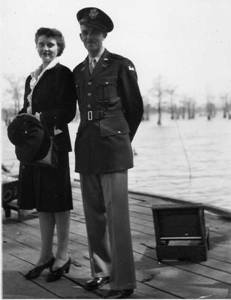
Scanned photo of Colonel Donovan and Mildred Vance at Reelfoot Lake in Cairo, Illinois.
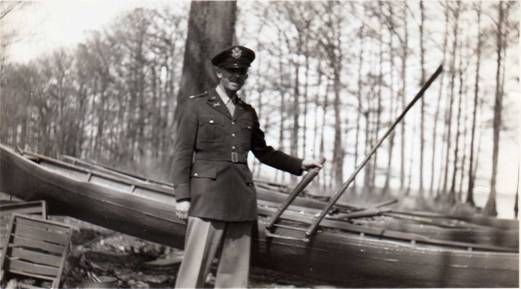
Scanned photo of Donovan Vance at Reelfoot Lake in Cairo, Illinois.
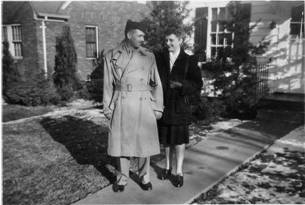
Scanned photo of Donovan and Mildred Vance.
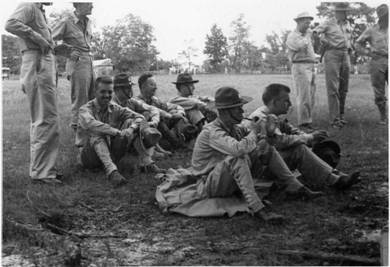
Scanned photo of Donovan Vance taken in the summer of 1941.
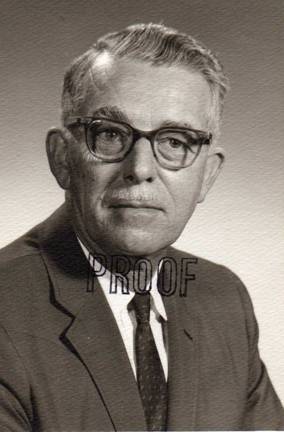
Scanned proof of a photo of Colonel Donovan Vance.
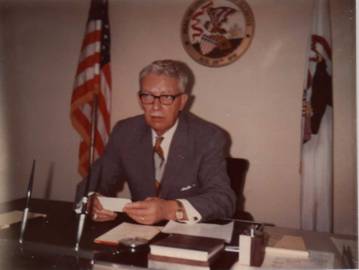
Scanned photo of Colonel Donovan Vance in his office in Springfield, Illinois.
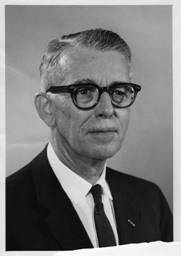
Scanned photo from Illinois Information Service.
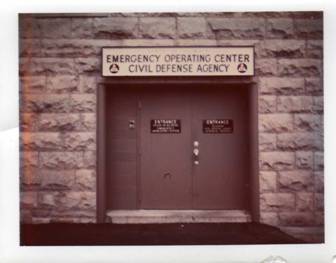
Scanned photo of the entrance to Illinois Civil Defense Headquarters in Springfield, Illinois.
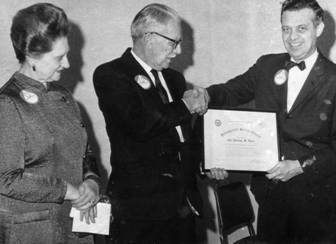
Scanned photo of Colonel Vance receiving a Distinguished Service Award.
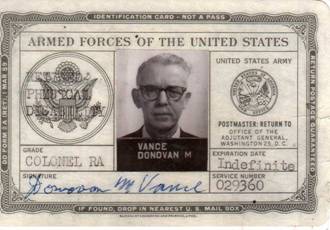
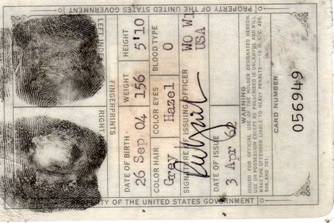
Scanned image of Colonel Donovan M. Vance’s Army ID card.
This paper was written in the spring of 2007 as part of William Urban's Hist300 Historiography class.
[1] Census of 1900 has Harry Vance (born Sept 1878 in Kansas) living in Suez (Mercer County) with Myrtle (born Sept 1879 in Illinois) and his father, John (born August 1840 in Ohio); Harry and John were both farm laborers. Harry and Clara Myrtle Milligan were married in Mercer County January 25, 1899.
[2] The Census of 1880 has Harry, the youngest child of J.C. and Mary Ann Vance (born 1844 in Illinois). His siblings were Lottie Rose (born 1867 in Illinois), Willis (born 1869 in Illinois), Fred (born 1872 in Kansas) and Orphea (born 1876 in Kansas). A Harry C. Vance (born 5 Sept 1878 in Kansas) died in Riverside, California, November 3, 1963.
[3] He may be that Harry C. Vance that the Census of 1920 locates in Sheridan County, Kansas, with wife, Olive (born 1900 in Kansas) and son Theodore (born 1918).
[4] Interview by author with Mrs. Elizabeth Vance, March 4, 2007; the census of 1920 shows Donovan living with his grandmother, M. E. Milligan (born 1851 in Pennsylvania) and his aunts, Nellie (b. 1886) and Elizabeth (b. 1890). In 1900 M.E. Milligan was living with her husband, W. H. (born 1842 in Illinois) in Pinckneyville in Perry County. A marriage between William H. Milligan and Mary E. McElvain took place in Perry County on December 27, 1871.
[5] Interview by author with Mrs. Elizabeth Vance, March 4, 2007.
[6] Interview by author with Mr. Charles Hallam, April 12, 2007; Ray E. Vance (born 1886) was then married and living in Abington.
[7] Interview by author with Mrs. Elizabeth Vance, March 4, 2007.
[8] “Colonel Vance, Former Mayor, Died In Peoria,” Monmouth Review-Atlas, October 2, 1971, 5.
[9] Interview by author with Mr. Everitt Hardin, March 31, 2007.
[10] Interview by author with Mr. Everitt Hardin, March 31, 2007.
[11] “Vance-Duke,” Monmouth Review-Atlas, January 30, 1926, 3.
[12] The Census of 1930 gives her birth year as 1906. At that time they were living at Rozetta in Henderson County.
[13] Benjamin Coleman (b. May 1870 in Illinois) and Anna Green (b. October 1873 in Illinois) Duke were married in Henderson County December 27, 1894; they were listed in the 1910 census with daughters Edith (b. February 1897) and Mildred (b. 1907).
[14] Interview by author with Mr. Bill Smallwood, April 1, 2007.
[15] Interview by author with Mr. Bill Smallwood, April 1, 2007.
[16] Interview by author with Mr. Everitt Hardin, March 31, 2007.
[17] Interview by author with Mr. Kenneth Wallace, April 15, 2007.
[18] “A Tale of Two Alums,” The Monmouth Oracle, April 29, 1982, 6 & 7.
[19] Takashi Komatsu, Takashi Komatsu’s Legacy (ed. M. Komatsu. Tokyo: Tokyo Printing Press, Inc, 1987), 18.
[20] “A Tale of Two Alums,” The Monmouth Oracle, April 29, 1982, 6 & 7.
[21] “A Tale of Two Alums,” The Monmouth Oracle, April 29, 1982, 6 & 7.
[22] Interview by author with Mr. Bud Barnes, February 15, 2007.
[23] Council Minutes, March 2, 1953, 275.
[24] Council Minutes, April 22, 1953, 281.
[25] “Vance defeats Pedigo For Mayor, Monmouth Goes Wet by 951 Votes, Wrestling And Boxing Legalized,” Monmouth Review-Atlas, April 22, 1.
[26] Council Minutes, May 4, 1953, 282.
[27] Council Minutes, May 4, 1953, 282.
[28] “Vance Becomes City’s Mayor At Council Session,” Monmouth Review-Atlas, May 5, 1953 1& 4.
[29] “Vance Becomes City’s Mayor At Council Session,” Monmouth Review-Atlas, May 5, 1953 1& 4.
[30] Council Minutes, May 4, 1953, 282.
[31] “May Form New Volunteer Fire Fighting Group,” Monmouth Review-Atlas, June 2, 1953, 3.
[32] Council Minutes, June 1, 1953, 286.
[33] “City Is Finding Many Problems To Meet Bills,” Monmouth Review-Atlas, June 2, 1953, 4.
[34] “City’s New Street Program Shaped By The Council,” Monmouth Review-Atlas, June 16, 1953, 4.
[35] “City’s New Street Program Shaped By The Council,” Monmouth Review-Atlas June, 16, 1953, 4.
[36] Council Minutes, August 3, 1953, 289.
[37] “Parking Meters On Square Will Aid Pay Raises,” Monmouth Review-Atlas, August 4, 1953, 3.
[38] Council Minutes, August 17, 1953, 289.
[39] “52 Meters Placed Around Town Square, City Approves Meters and Bulldozer,” Monmouth Review-Atlas, August 18, 1953, 3.
[40] Council Minutes, October 5, 1953, 291.
[41] “Council Says City Has Need Of Water Plant,” Monmouth Review-Atlas, October 6, 1953, 3.
[42] Council Minutes, December 21, 1953, 295.
[43] “Council Will Ask Approval Of Bong Issue,” Monmouth Review-Atlas, December 22, 1953, 3.
[44] Council Minutes, February 15, 1954, 298.
[45] “New Water Plant Will Be Pushed By The Council,” Monmouth Review-Atlas, February 16, 1954, 3.
[46] Council Minutes, March 15, 1954, 301.
[47] “Council Busy Last Night At Long Session,” Monmouth Review-Atlas, March 16, 1954, 4.
[48] Council Minutes, April 5, 1954, 304.
[49] “Aldermen Had Very Busy Time,” Monmouth Review-Atlas, April 6, 1954, 3.
[50] “Council Talked Of Many Things Monday Night,” Monmouth Review-Atlas, June 8, 1954, 4.
[51] Council Minutes, August 16, 1954, 320.
[52] Council Minutes, September 7, 1954, 321.
[53] “City Votes To Accept Tracts For Annexation,” Monmouth Review-Atlas, September 8, 1954, 4.
[54] Council Minutes, October 18, 1954, 323.
[55] “Allow Parking On One Side Only On Six Blocks,” Monmouth Review-Atlas, October 19, 1954, 4.
[56] “City Votes To Accept Tracts For Annexation,” Monmouth Review-Atlas, September 8, 1954, 4.
[57] Council Minutes, November 15, 1954, 325.
[58] “Hogs Banished From The City,” Monmouth Review-Atlas, November 16, 1954, 3.
[59] “Traffic Rated As The City’s Top Current Problem,” Monmouth Review-Atlas, November 16, 1954, 3.
[60] “Monmouth May Some Day Have Valid City Plan,” Monmouth Review-Atlas, February 22, 1955, 3.
[61] Council Minutes, February 21, 1955, 333.
[62] Council Minutes, March 21, 1955, 335.
[63] “Council Takes First Steps Towards A Plan,” Monmouth Review-Atlas, March 22, 1955, 4.
[64] “Appropriation Ordinance Was Put Into Mill,” Monmouth Review-Atlas, May 3, 1955, 3 & 4.
[65] Interview by author with Mr. Kenneth Wallace, April 15, 2007.
[66] “Ralph J. Lusk Is No Longer On The Force,” Monmouth Review-Atlas, July 6, 1955, 3.
[67] “Consider Plan To Angle Park Sixty More Cars,” Monmouth Review-Atlas, September 20, 1955, 3.
[68] Council Minutes, January 16, 1956, 354.
[69] “Find That Water Supply Is Safe,” Monmouth Review-Atlas, January 17, 1956, 4.
[70] “Find That Water Supply Is Safe,” Monmouth Review-Atlas, January 17, 1956, 4.
[71] Council Minutes, February 6, 1956, 355.
[72] “City Would Go Along With The Hospital Plan,” Monmouth Review-Atlas, February 7, 1956, 3.
[73] “Council Session Last Night Was Very Busy One,” Monmouth Review-Atlas, March 6, 1956, 4.
[74] “City Council Has Approved Pay Increases,” Monmouth Review-Atlas, May 22, 1956, 1 & 4.
[75] “City Is Given Original Plans For City Hall,” Monmouth Review-Atlas, July 3, 1956, 3.
[76] Council Minutes, July 2, 1956, 362.
[77] “Council Session Held Last Night,” Monmouth Review-Atlas, August 21, 1956, 4.
[78] “Council Shows It Is Willing To Make Change,” Monmouth Review-Atlas, September 5, 1956, 4.
[79] “Council Session Held Last Night Was A Busy One,” Monmouth Review-Atlas, December 4, 1956, 3.
[80] Council Minutes, January 21, 1957, 371.
[81] “Will Attempt To Open A Crossing,” Monmouth Review-Atlas, January 22, 1957, 3.
[82] Council Minutes, March 4, 1957, 374.
[83] “Only One Voter In Twenty Went To Polls Tuesday,” Monmouth Review-Atlas, April 17, 1957, 3.
[84] “East Broadway Cost Sharing Is Worked Out,” Monmouth Review-Atlas, December 3, 1957, 3.
[85] “Council Agrees To Press For Better Phones,” Monmouth Review-Atlas, November 4, 1958, 1 & 8.
[86] Council Minutes, December 15, 1958, 407.
[87] “City Is Divided Into Four Wards By The Council,” Monmouth Review-Atlas, December 16, 1958, 3.
[88] “Present Fire Station Will Be Sold Very Soon,” Monmouth Review-Atlas, April 7, 1959, 4.
[89] Council Minutes, April 23, 1959, 416.
[90] “Time Change Is Given Approval,” Monmouth Review-Atlas, April 24, 1959, 3.
[91] Council Minutes, June 15, 1959, 419.
[92] Council Minutes, June 15, 1959, 419.
[93] “Go Ahead With Plans For New Fire Station,” Monmouth Review-Atlas, June 16, 1959, 3.
[94] Council Minutes, September 21, 1959, 420.
[95] “Tornadic Storm Takes One Life And Causes Extensive Damage To Property Here,” Monmouth Review-Atlas, September 28, 1959, 1 & 4.
[96] Council Minutes, October 5, 1959, 421.
[97] Council Minutes, September 19, 1960, 431.
[98] “Safety Record Of City Given Commendations,” Monmouth Review-Atlas, September 20, 1960, 3.
[99] Council Minutes, October 17, 1960, 432.
[100] “City Council Had Busy Time Last Evening,” Monmouth Review-Atlas, October 18, 1960, 3.
[101] Council Minutes, January 3, 1961, 436.
[102] Council Minutes, January 16, 1961, 436.
[103] “Name Planning Commission To Do Zoning Study,” Monmouth Review-Atlas, January 17, 1961, 3.
[104] Interview by author with Mr. Everitt Hardin, March 31, 2007.
[105] “Name Planning Commission To Do Zoning Study,” Monmouth Review-Atlas, January 17, 1961, 3.
[106] Council Minutes, April 24, 1961, 439.
[107] “Vance Loses To Opponent By Scant 21 Votes,” Monmouth Review-Atlas, April 19, 1961, 1 & 3.
[108] “Allan Walters Assumes Duties As City’s Mayor,” Monmouth Review-Atlas, May 2, 1961, 3.
[109] Interview by author with Mr. Everitt Hardin, March 31, 2007.
[110] Interview by author with Mr. Bill Smallwood, April 1, 2007.
[111] “Colonel Vance, Former Mayor, Died In Peoria,” Monmouth Review-Atlas, October 2, 1971, 5.
[112] Interview by author with Mrs. Elizabeth Vance, March 4, 2007.
[113] “Colonel Vance, Former Mayor, Died In Peoria,” Monmouth Review-Atlas, October 2, 1971, 5.